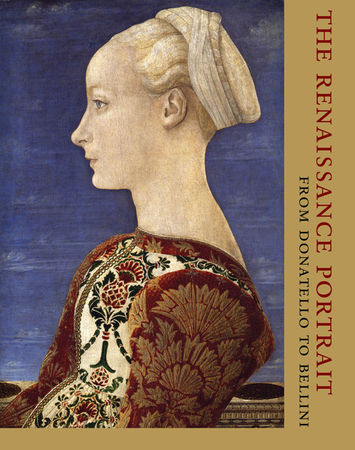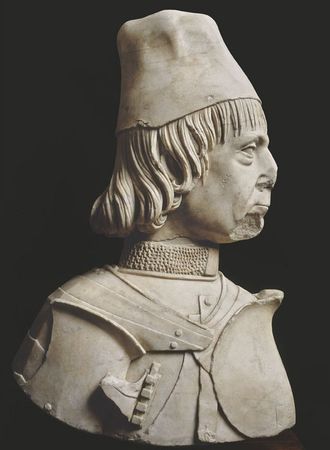21 décembre 2011
"The Renaissance Portrait from Donatello to Bellini" @ The Metropolitan Museum of Art
NEW YORK, N.Y.- The first great age of portraiture in Europe, both north and south of the Alps, took place in the 15th century. For the first time since antiquity, portraits were used to record the features of a family member for future generations, celebrate a prince or warrior, extol the beauty of a woman, or make possible the exchange of a likeness among friends. The Renaissance Portrait from Donatello to Bellini, on view at The Metropolitan Museum of Art from December 21, 2011, through March 18, 2012, will celebrate the Italian contribution to this rediscovery of the individual in art. It will bring together approximately 160 works—by artists including Donatello, Filippo Lippi, Botticelli, Verrocchio, Ghirlandaio, Pisanello, Mantegna, Giovanni Bellini, and Antonello da Messina— media ranging from painting and manuscript illumination to marble sculpture and bronze medals, testifying to the new vogue for and uses of portraiture in 15th-century Italy.
During the early Renaissance, artists working in Florence, Venice, and the courts of Italy created magnificent portrayals of the people around them—from heads of state and church to patrons, scholars, poets, and artists—concentrating for the first time on producing recognizable likenesses and expressions of personality. The rapid development of portraiture was linked closely to Renaissance society and politics, ideals of the individual, and concepts of beauty. The object may have been to commemorate a significant event—a marriage, death, the accession to a position of power—or it may have been to record the features of an esteemed member of the family for future generations.
Featuring many rare international loans, The Renaissance Portrait from Donatello to Bellini will present an unprecedented survey of the period and provide new research and insight into the early history of portraiture. The exhibition will be divided into three sections and will span a period of eight decades. Beginning in Florence, where independent portraits first appeared in abundance, it moves to the courts of Ferrara, Mantua, Bologna, Milan, Urbino, Naples and papal Rome, and ends in Venice, where a tradition of portraiture asserted itself surprisingly late in the century.
In Florence, the most striking innovations occurred first in sculpture and were then taken up in painting. In the courts, thanks in large measure to the genius of Pisanello, the medal became the preferred means of recording a likeness. The medals, which were durable, could be produced in multiple casts, and were easily exchanged among the social elite. In Venice the painted portrait held sway, thanks to the achievements of Antonello da Messina and Giovanni Bellini, whose portraits resolutely abandoned the dominant Italian convention for the profile to present the sitter turned three-quarters, his or her distant gaze and delicately modeled features expressing hints of an interior life.
As Leon Battista Alberti declared in his treatise on painting, composed in 1435: “Painting possesses a truly divine power in that not only does it make the absent present (as they say of friendship), but it also represents the dead to the living many centuries later, so that they are recognized by spectators with pleasure and deep admiration for the artist.”
During the early Renaissance, artists working in Florence, Venice, and the courts of Italy created magnificent portrayals of the people around them—from heads of state and church to patrons, scholars, poets, and artists—concentrating for the first time on producing recognizable likenesses and expressions of personality. The rapid development of portraiture was linked closely to Renaissance society and politics, ideals of the individual, and concepts of beauty. The object may have been to commemorate a significant event—a marriage, death, the accession to a position of power—or it may have been to record the features of an esteemed member of the family for future generations.
Featuring many rare international loans, The Renaissance Portrait from Donatello to Bellini will present an unprecedented survey of the period and provide new research and insight into the early history of portraiture. The exhibition will be divided into three sections and will span a period of eight decades. Beginning in Florence, where independent portraits first appeared in abundance, it moves to the courts of Ferrara, Mantua, Bologna, Milan, Urbino, Naples and papal Rome, and ends in Venice, where a tradition of portraiture asserted itself surprisingly late in the century.
In Florence, the most striking innovations occurred first in sculpture and were then taken up in painting. In the courts, thanks in large measure to the genius of Pisanello, the medal became the preferred means of recording a likeness. The medals, which were durable, could be produced in multiple casts, and were easily exchanged among the social elite. In Venice the painted portrait held sway, thanks to the achievements of Antonello da Messina and Giovanni Bellini, whose portraits resolutely abandoned the dominant Italian convention for the profile to present the sitter turned three-quarters, his or her distant gaze and delicately modeled features expressing hints of an interior life.
As Leon Battista Alberti declared in his treatise on painting, composed in 1435: “Painting possesses a truly divine power in that not only does it make the absent present (as they say of friendship), but it also represents the dead to the living many centuries later, so that they are recognized by spectators with pleasure and deep admiration for the artist.”
Andrea Mantegna, Cardinal Ludovico Trevisan, Ca. 1459-60. Tempera on wood, 17 7/8 x 13¾ in. Gemäldgalerie, Staatliche Museen zu Berlin
Sperandio of Mantua (Sperandio di Bartolommeo Savelli; Mantua, ca. 1425/-after 1504, Venice). Ercole I d’Este, 1475. Marble, 22 7/8 x 15 x 6 ¼ in. Palazzina di Marfisa d’Este, Ferrara.
Publicité
Publicité
Commentaires

/https%3A%2F%2Fprofilepics.canalblog.com%2Fprofilepics%2F1%2F0%2F100183.jpg)
/https%3A%2F%2Fstorage.canalblog.com%2F03%2F02%2F119589%2F96711876_o.jpg)
/https%3A%2F%2Fstorage.canalblog.com%2F11%2F31%2F119589%2F94773502_o.jpg)
/https%3A%2F%2Fstorage.canalblog.com%2F20%2F83%2F119589%2F94772815_o.jpg)
/https%3A%2F%2Fstorage.canalblog.com%2F26%2F72%2F119589%2F75604929_o.jpg)
/https%3A%2F%2Fstorage.canalblog.com%2F59%2F60%2F119589%2F26458628_o.jpg)





/http%3A%2F%2Fstorage.canalblog.com%2F84%2F50%2F577050%2F40250600_p.jpg)
/http%3A%2F%2Fstorage.canalblog.com%2F05%2F46%2F119589%2F121354786_o.jpg)
/http%3A%2F%2Fstorage.canalblog.com%2F81%2F57%2F119589%2F118915768_o.jpg)
/http%3A%2F%2Fstorage.canalblog.com%2F01%2F86%2F119589%2F95604634_o.jpg)